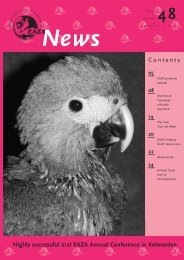EAZA NEWS 65 - European Association of Zoos and Aquaria
EAZA NEWS 65 - European Association of Zoos and Aquaria
EAZA NEWS 65 - European Association of Zoos and Aquaria
Create successful ePaper yourself
Turn your PDF publications into a flip-book with our unique Google optimized e-Paper software.
In conclusion we suggest that molecular genetic methods<br />
successfully helped elucidate the correct taxonomy <strong>and</strong> geographic<br />
origin <strong>of</strong> breeding stock known as ‘Chesteri’. We recommend that<br />
‘Chesteri’ be referred to now as H. kuda that originated from an<br />
Indonesian wild population. This study gives an example <strong>of</strong> the<br />
invaluable application <strong>of</strong> modern molecular techniques in the<br />
management <strong>of</strong> species in public aquaria, in this case providing<br />
taxonomic clarification.<br />
ReFeReNCeS<br />
l casey, s. P., hall, h. j., stanley, h. f. & vincent, a. c. j. (2004). the origin <strong>and</strong> evolution<br />
<strong>of</strong> seahorses (genus hippocampus): a phylogenetic study using the cytochrome b gene <strong>of</strong><br />
mitochondrial dna. molecular Phylogenetics <strong>and</strong> evolution 30, 261-272.<br />
l lourie, s. a. (2003). fin-clipping procedure for seahorses. in Project seahorse technical<br />
bulletin, p. 4: Project seahorse, fisheries centre, university <strong>of</strong> british columbia.<br />
l lourie, s. a., foster, s. j., cooper, e. w. t. & vincent, a. c. j. (2004). a guide to the<br />
identification <strong>of</strong> seahorses: Project seahorse <strong>and</strong> traffic north america. washington d.<br />
c.<br />
l teske, P. r., hamilton, h., Palsboll, P., choo, c. K., gabr, h., lourie, s. a., santos, m.,<br />
sreepada, a., cherry, m. i. & matthee, c. a. (2005). molecular evidence for long-distance<br />
colonization in an indo-Pacific seahorse lineage. marine ecology Progress series 286, 249-<br />
260.<br />
Barbary lions: a<br />
viable population?<br />
Pete Thompson, Wildlink International, United Kingdom<br />
Since Hemmer’s key 1978 paper on the Barbary, or Atlas,<br />
lion was published, three decades have passed. What<br />
is the current level <strong>of</strong> genetic diversity <strong>of</strong> this cat in the<br />
wild? New research aims to find out, with important<br />
conclusions for collections.<br />
The scientific case for Barbary/Atlas lion (Panthera leo leo) preservation<br />
is based upon the undetermined existence <strong>of</strong> genetic diversity already<br />
lost in the wild. <strong>Zoos</strong> <strong>and</strong> private collections in Europe <strong>and</strong> other<br />
regions have expressed strong interest in taking part in the urgent<br />
population assessment currently underway. The outcome will be known<br />
approximately 4 – 5 months after samples are received for DNA testing<br />
<strong>and</strong> analysis.<br />
There is a pressing need to use recently published genetic research<br />
to establish whether the remaining population is still viable. Recent<br />
peer-reviewed research papers provide the methodological basis using<br />
knowledge gained from mitochondrial genome analysis. Testing <strong>of</strong> the<br />
hypervariable region I (HVR I) <strong>and</strong> cytochrome b sequences is sufficient<br />
for the identification <strong>of</strong> the maternal Barbary line. This provides a robust<br />
<strong>and</strong> scientifically valid method <strong>of</strong> identifying living animals that carry the<br />
genes <strong>of</strong> the Barbary subspecies, as distinct from other Asiatic <strong>and</strong> sub-<br />
Saharan lion subspecies.<br />
The IUCN Conservation Breeding Specialist Group states: ‘The DNA<br />
work <strong>and</strong> historical investigations to determine if there are legitimate<br />
(<strong>and</strong> genetically healthy) Barbary lions in captivity with a possibility for<br />
restoration…would be useful information.’ Furthermore: ‘CBSG endorses<br />
the need for more data to document the extent <strong>of</strong> divergence <strong>of</strong> the<br />
historical population <strong>of</strong> Barbary lions from other lion populations <strong>and</strong><br />
the possibility that descendants from Barbary lions still carry their genes<br />
within captive programmes.’<br />
Wildlink International is fortunate to have the expert assistance <strong>of</strong><br />
Pr<strong>of</strong>essor Helmut Hemmer (IUCN Cat Specialist Group Member) <strong>and</strong><br />
Dr Joachim Burger <strong>of</strong> the University <strong>of</strong> Mainz in the testing <strong>and</strong> analysis<br />
<strong>of</strong> both the samples <strong>and</strong> extended taxon reports. Assuming a positive<br />
outcome, a managed ex situ breeding programme will also keep the<br />
door open for a bona fide reintroduction to a protected area in future<br />
should this ever be possible.<br />
FURTHeR ReADINg<br />
l ’if animals contain the genes <strong>of</strong> extinct populations, they should prove crucial for preserving<br />
the overall genetic diversity <strong>of</strong> the species. <strong>and</strong>…even though the moroccan King’s lions are<br />
unlikely to be maternally barbary, it would be worthwhile maintaining the collection for the<br />
purpose <strong>of</strong> preserving overall lion genetic diversity.’ barnett r, yamaguchi n, barnes i, cooper a<br />
(2006). lost population <strong>and</strong> preserving genetic diversity in the lion Panthera leo: implications<br />
for its ex situ conservation. conservation genetics 7: 507–514.<br />
l ’Panthera leo leo…joins the asian lion clade, though…clearly separated from its asian<br />
sister.’ they have genes ‘not found in sub-saharan african lions’… ‘this demonstrates on the<br />
mtdna level the unique nature <strong>of</strong> the relic zoo population <strong>of</strong> the barbary lion’ burger j, hemmer<br />
h (2006). urgent call for further breeding <strong>of</strong> the relic zoo population <strong>of</strong> the critically endangered<br />
barbary lion. [Panthera leo leo (linnaeus 1758)]. european journal <strong>of</strong> wildlife research. 2006,<br />
52: 54-58<br />
one <strong>of</strong> the last atlas lionesses at the end <strong>of</strong> the 19th century; taKen at the toP <strong>of</strong><br />
the Pass on the bÙne-duvivier road in algeria (hemmer, 1978).<br />
15

















